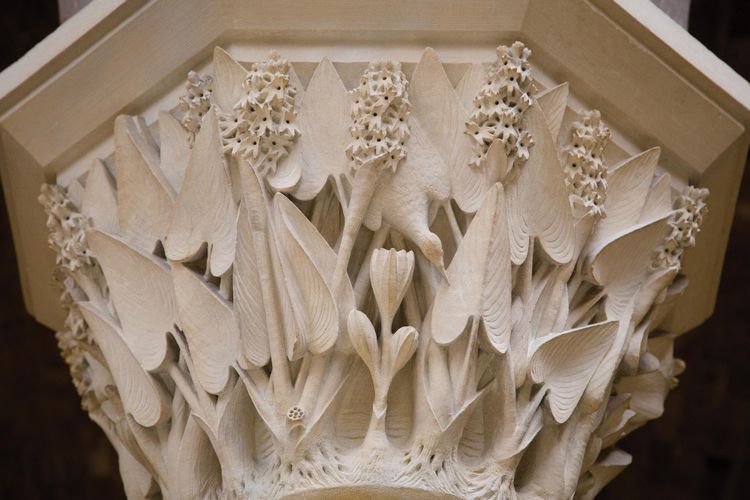ART WORLD NEWS
The scientific brotherhood: Pre-Raphaelite art put under the microscope
[ad_1]
A living ecosystem: one of the O’Shea brothers’ startlingly vivid carvings of a capital inside the Oxford Museum of Natural History
Courtesy Natural History Museum, London
John Holmes may be said to have achieved the near impossible in finding a little studied aspect of Pre-Raphaelitism and producing a stimulating book covering not only painting and architecture but also poetry and prose, as befits the professor of Victorian literature and culture at Birmingham University.
Tate Britain’s 2012 exhibition made a not wholly convincing attempt to promote the Pre-Raphaelites as the “Victorian avant-garde”. Holmes avoids this temptation, instead outlining what he calls “the Pre-Raphaelite project”, inaugurated in the pages of the Brotherhood’s short-lived magazine The Germ (1850) and linking all aspects of art and literature.
From first looking at The Germ, somewhat neglected by scholars, Holmes finds a rich seam in the relationship between art and science, recognising that the young Pre-Raphaelites had been born into a self-consciously modern, scientific age. Rarely read essays by Frederic Stephens and John Lucas Tupper, an anatomical illustrator, together with the poem Newton by Walter Deverell, are all seen to contribute to the overarching idea that adherence to fact and close study of the natural world assisted the moral purpose of art, a principle also promoted by Ruskin, who provided early public support for paintings shown at the Royal Academy. New thought about the relevance of deep scientific observation allows interesting discussion of familiar images such as Millais’s Ophelia (1851-52), Holman Hunt’s Hireling Shepherd (1851) and Dyce’s Pegwell Bay (1858-60).
New thought about the relevance of deep scientific observation allows interesting discussion of familiar images
The concept of science is expanded to include many subjects, including fundamentals such as chemistry and geology as well as anatomy, astronomy, geography and natural history (through the study of nature and landscape), and even psychology (as demonstrated in William Michael Rossetti’s little-known poem Mrs Holmes Grey).
The Pre-Raphaelites’ religious paintings can also be seen to have been influenced: although Christina Rossetti considered that science “existed under suffrance”, her brother William Michael could express in an essay of 1857, “The Externals of Sacred Art”, “every reason to believe that science could help to reach towards a fuller and truer understanding of the foundations of faith”. Natural theology, no longer in currency but much discussed in the mid-19th century, is considered in one chapter through its antithesis with scientific naturalism, as part of the Darwinian debate.
Architecture attracts Holmes’s chief attention, and there is no escaping the feeling that the book has developed out of stimulating new research on the genesis, construction and decoration in the 1850s and 1860s of the Oxford Museum, here called “the greatest single work of Pre-Raphaelite art”. This is not entirely a novel idea: at the 1862 International Exhibition the work of William Morris’s newly founded firm had been seen to embody a kind of “practical Pre-Raphaelitism”, but there has been little follow-up to this in modern scholarship.
Careful and intriguing analysis of the written sources and the visible evidence underpins the significance of the museum—Henry Acland, its co-founder with Ruskin, reconciling Darwinism with his belief in God as a divine artist, and the O’Shea brothers’ astonishing carvings shown to be not merely decorative but offering “a living ecosystem”.
Admitting to piecing together isolated examples from the late 1850s and 1860s, when Pre-Raphaelitism was anyway more diffuse, Holmes makes a bold but convincing argument for the new Natural History Museum in South Kensington as “a second Pre-Raphaelite museum”. The naturalist Richard Owen seems an unlikely Pre-Raphaelite, but he was a member of the Hogarth Club, and is here revealed to have been “well liked by writers and artists”, and to have instigated the scheme of bizarre animal decoration designed by Alfred Waterhouse. The overlooked 1881 Holman Hunt portrait of Owen—“a lion in winter” and “a reluctant Lear”—is rightly and cleverly contrasted with John Collier’s urbane 1883 portrait of Thomas Huxley, modern man of science, as a neat conclusion to the book.
There are other interesting themes and pockets of research in this judiciously illustrated study (half of the 150 plates are in colour), all benefiting from Yale’s impeccable editing and design. It concludes by reiterating that “the Pre-Raphaelite project… had brought a new rigour and intellectual independence to the arts”. While this may not convince every reader, it still stands as an original and useful addition to the literature.
Stephen Wildman is an Emeritus Professor of the History of Art Department at Lancaster University
- John Holmes, The Pre-Raphaelites and Science, Yale University Press in association with the Paul Mellon Centre for Studies in British Art, 320pp, £35, $50 (hb)
[ad_2]
Source link













